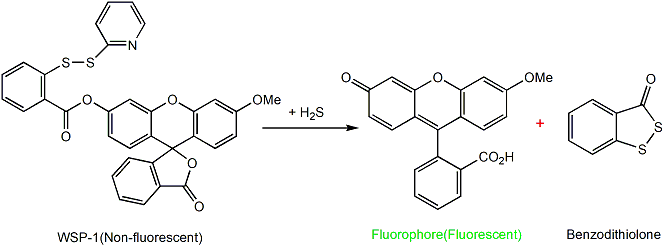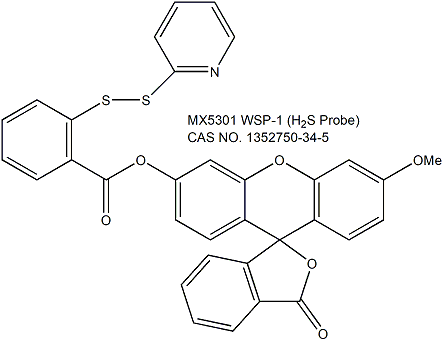产品简介:
WSP-1 (H2S Probe) 硫化氢荧光探针
产品标签
WSP-1 (Washington State Probe-1);WSP-5;硫化氢(H2S)特异性探针;PAG (DL-propargylglicine) 硫化氢合成抑制剂;Hypotaurine H2S清除剂;CAS NO:1352750-34-5;
产品信息
|
产品名称
|
产品编号
|
CAS NO.
|
规格
|
价格(元)
|
|
WSP-1 (H2S Probe) 硫化氢荧光探针
|
MX5301-1MG
|
1352750-34-5
|
1mg
|
978
|
|
WSP-1 (H2S Probe) 硫化氢荧光探针
|
MX5301-5MG
|
1352750-34-5
|
5mg
|
2980
|
产品描述
WSP-1 (Washington State Probe-1)是由M. Xian团队开发的一种含活性二硫化物的荧光探针,特别设计用来检测生物样本和细胞内的硫化氢(H2S)。通过基于反应的荧光开启策略,WSP-1选择性且快速与H2S反应,生成苯丙二硫醇酮(benzodithiolone)和一种荧光化合物(Ex=465nm,Em=515nm)(反应机制见下图)。

参考文献:C. Liu, et al. Capture and Visualization of Hydrogen Sulfide via A Fluorescent Probe. Angew Chem Int Ed Engl. 2011 Oct 24; 50(44): 10327–10329.
产品特性
1) CAS NO:1352750-34-5
2) 化学名:3'-methoxy-3-oxo-3H-spiro[isobenzofuran-1,9'-xanthen]-6'-yl 2-(pyridin-2-yldisulfanyl)benzoate
3) 同义名:Washington State Probe-1;硫化氢荧光探针;H2S荧光探针;
4) 分子式:C33H21NO6S2
5) 分子量:591.7
6) 纯度:≥95%
7) Ex/Em:465/515nm
8) 溶解性:溶于DMSO(~2mg/ml)、DMF(~20mg/ml)
9) 化学结构式:
保存与运输方法
保存:-20ºC避光干燥保存,至少2年有效。
运输:冰袋运输。
使用方法【见附录 使用延伸资料阅读】
1、 储存液制备
将低温保存的产品从冰箱取出,置于室温回温至少20min。低速离心3-5min。之后往瓶内加入适量无水DMSO充分溶解配成5mM储存液(比如,1mg WSP-1(Mw: 591.7)加入338μl DMSO)。按照单次用量分装冻存,避免反复冻融,至少3个月稳定。
2、 工作浓度
正式实验前,取5mM储存液用适当缓冲液或培养基稀释到所需工作浓度即可。具体的工作浓度请参考文献或根据自身实验需求来进行优化调整。参考下方一些实验数据,来自公开文献,仅作参考。
应用示例1:使用WSP-1(10 µM)检测RFL-6细胞在硫化物供体GYY4137(10–100 µM)内的硫化物水平,经流式细胞仪(FL1通道)来定量分析。文献来源:Cortese-Krott MM et al. Nitrosopersulfide (SSNO(-)) accounts for sustained NO bioactivity of S-nitrosothiols following reaction with sulfide. Redox Biol. 2014 Jan 11;2:234-44. PMID: 24494198.
应用示例2:为了证明H2S在NO调控的侧根形成中起到的重要调控作用,使用WSP-1对植物细胞进行内源性H2S的示踪和生物成像检测。番茄幼苗根部转移含WSP-1(15 µM)的20 mM Hepes-NaOH buffer(pH 7.5)。25℃避光孵育40min,根部用蒸馏水清洗后立即用荧光显微镜检测(Ex/Em=465/515nm)。文献来源:Li YJ et al. In site bioimaging of hydrogen sulfide uncovers its pivotal role in regulating nitric oxide-induced lateral root formation. PLoS One. 2014 Feb 27;9(2):e90340. PMID: 24587333
注意事项
1)对我司提供的硫化氢探针(WSP-1,WSP-5),我们只做化合物纯度和结构完整性的测定,并未针对这些化合物进行生物活性的测定。关于这部分的使用数据,请更多参考文献资料,或见我司整理的附录 硫化氢探针(WSP-1,WSP-5)使用延伸资料阅读。
2)为了您的安全和健康,请穿实验服并戴一次性手套操作。
相关产品
|
货号
|
名称
|
规格
|
|
MX5301-1MG
|
WSP-1 (H2S Probe) 硫化氢荧光探针
|
1mg
|
|
MX5302-1MG
|
WSP-5 (H2S Probe) 硫化氢荧光探针
|
1mg
|
|
MX5305-50MG
|
Hypotaurine 亚牛磺酸
|
50mg
|
|
MX5306-250MG
|
DL-Propargylglycine DL-炔丙基甘氨酸
|
250mg
|
|
MX5307-1MG
|
DL-Propargylglycine (hydrochloride) DL-炔丙基甘氨酸盐酸盐
|
1mg
|
— —Written/Edited by V. Shallan【版权归MKBio懋康所有】
上海懋康生物科技有限公司是一家涉足于生命科学和生物技术领域研究的试剂、仪器和实验室消耗品与实验服务工作,主要从事细胞生物学、植物学、分子生物学、免疫学、生物化学、蛋白组学。生物制药与诊断试剂研发生产等领域。 本公司秉承“以人为本,以诚为信、合同守信”的经营理念。坚持"品质保障"的原则为广大客户提供优质产品。
文献引用:
「1」Hu YM et. Reactive oxygen species-triggered off-on fluorescence donor for imaging hydrogen sulfide delivery in living cells. Chem. Sci., 2019,10, 7690-7694
ROS-triggered H2S release, a commercially available probe (WSP-1), whose fluorescence can be selectively turned on by H2S,17 was used for the detection of H2S in HeLa cells. As shown in Fig. S17 (images c–e),† the fluorescence of WSP-1 in the green channel rises with increasing the dose of NAB in the presence of H2O2, suggesting the generation of the gradually increased H2S.
「2」Zhao AS et al. Hydrogen sulphide-releasing aspirin enhances cell capabilities of anti-oxidative lesions and anti-inflammation. Med Gas Res. 2019 Jul-Sep;9(3):145-152. PMID: 31552879
HUVECs were cultured with each sample on coverslips for 24 hours, and then incubated with 250 μM H2S fluorescent probe WSP-1 (Maokangbio, Shanghai, China) for 30 minutes at 37o C away from light. After washing by PBS, cells were imaged at 476 nm by fluorescence microscope, and the fluorescent intensity was measured by Image J software.
「3」Xie Congkun et al. FeS@BSA Nanoclusters to Enable H2S‐Amplified ROS‐Based Therapy with MRI Guidance. Adv. Sci. 2020, 7, 1903512
WSP-1 (H2S probe) was purchased from Shanghai Maokang Bio Co., Ltd. Intracellular H2S detection: WSP-1 was used as intracellular H2S probe. Briefly, after treatment of cells with FeS@BSA nanoclusters (pH = 7.4 and pH = 6.0) for 6 h (PBS for control), WSP-1 (15 μM) was added, followed by incubation for 30 min. Subsequently, the cells were washed twice with PBS and observed under fluorescent microscope (Ex/Em:465/515 nm).
「4」Wang G et al. Zinc sulfide nanoparticle-decorated fibre mesh to enable localized H2S-amplified chemotherapy. Chem. Commun., 2020,56, 4304-4307
To investigate the intracellular production of H2S, a WSP-1 hydrosulfide probe was used following the
standard protocol. In the presence of H2S, emission at 516 nm could be observed with the excitation at λ = 480 nm. WSP-1 hydrosulfide probe was obtained from Maokangbio(Shanghai, China)
「5」Ge Chunpo, et al. A novel NIR fluorescence probe with cysteine-activated structure for specific detection of cysteine and its application in vitro and in vivo. Talanta Volume 223, Part 2, 1 February 2021, 121758
NaHS and WSP-1 were obtained from Aladain (Shanghai, China) and Maokang Biotechnology (Shanghai, China), respectively.
【6】MengyunYao et al. A ROS-responsive, self-immolative and self-reporting hydrogen sulfide donor with multiple biological activities for the treatment of myocardial infarction. Bioactive Materials. Available online 21 July 2021.
A H2S probe WSP-1 was purchased from MKBio (Shanghai, China). H9c2 myocardial cells were seeded and cultured according to the procedures of 2.6. Cells were first treated with HSD-R (5 μM) and WSP-1 (10 μM) for 60 min. After removal of excess HSD-R and WSP-1, cells were incubated in fresh medium with PBS (control), low-dose Rosup at 50 μg/mL (Rosup (L)), or high-dose Rosup at 100 μg/mL (Rosup (H)) for 30 min. After fixation, the cells were observed and imaged under a confocal laser scanning microscope (CLSM). Red channel of HSD-R was recorded at 690–720 nm with excitation at 670 nm. Green channel of WSP-1 was recorded at 510–570 nm with excitation at 490 nm.
【7】Henan Zhao et al. Nanomessenger-Mediated Signaling Cascade for Antitumor Immunotherapy. ACS Nano 2021, 15, 8, 13188–13199 Publication Date:August 3, 2021
H2S probe (WSP-1, cat. 1352750-34-5) was obtained from Maokang Bio (Shanghai, China).
【8】Tian L, Pei R, Zhang X, Li K, Zhong Y, Luo Y, Zhou S-F and Chen L (2022) Tumor Cell-Specific and Lipase-Responsive Delivery of Hydrogen Sulfide for Sensitizing Chemotherapy of Pancreatic Cancer. Front. Bioeng. Biotechnol. 10:934151. doi: 10.3389/fbioe.2022.934151
Washington State Probe-1 (WSP-1) for fluorescence imaging of H2S release in living cells was from Maokang Bio-Tech Co. Ltd. (Shanghai, China).
Fluorescence Imaging of H2S Release From the Micelles in Living Cells
Panc-1 cells were seeded in a 35 mm confocal dish at 1.0×105 cells per well, and cultured with a full medium in a humidified atmosphere of 5% CO2 at 37°C. When the cells grew to about 70%, the medium was removed, and a 1.0 ml fresh serum-free medium containing 0.01 mg/ml of DA@Ms and DA@Ms-A were then added and incubated for 2 and 4 h, respectively. After that, the cells were washed with PBS, incubated with a 15 μM WSP-1 probe in PBS for 40 min, then washed with PBS three times and added with 1 ml PBS. The generation of H2S was observed immediately by CLSM with an excitation wavelength fixed at 488 nm.
[9] Chen J, Xue F, Du W, Yu H, Yang Z, Du Q, Chen H. An Endogenous H2S-Activated Nanoplatform for Triple Synergistic Therapy of Colorectal Cancer. Nano Lett. 2022 Aug 10;22(15):6156-6165. doi: 10.1021/acs.nanolett.2c01346. Epub 2022 Jul 19. PMID: 35852844.
Calcein-AM and PI, WSP-1, monodansylcadaverine (MDC) were bought from Maokang biotechnology. To evaluate intracellular H2S content, WSP-1 was used as the H2S probe. HCT116 cells were seeded in a CLSM-exclusive culture dish with the density of 5 × 104 cells and divided to 5 groups: 1) control, 2) NaHS (100 μM), 3) Cur-P ([Cur]=20 μM) + NaHS, 4) HMPB (50 ppm) + NaHS, 5) Cur-P@HMPB (50 ppm) + NaHS. In detail, after co-incubation with different formulations for 10 h, cells were incubated with NaHS for further 2 h. Then, the cells were dyed with WSP-1 (100 μM) at 37 °C for 30 min before detection with CLSM.
|